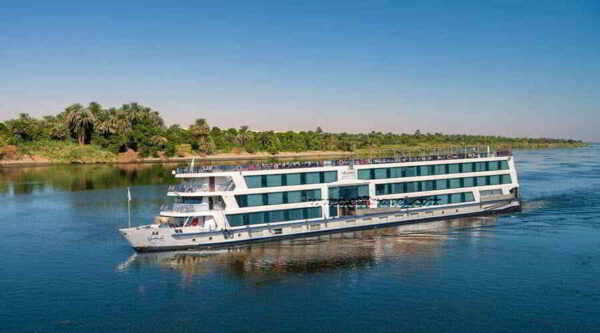The Nile River Between the Past and Present
The Nile River, this flowing giant that meanders through the embrace of fertile lands, tells the story of an ancient civilization and bears witness to a long history of generosity and life. It is not merely a watercourse piercing the African continent, but rather the lifeline without which the heartbeat of Egypt would cease and the tributaries of life would dry up.
In the beginning, there was the Nile, and since the dawn of history, it has been the inexhaustible source that poured fertility and growth into the womb of the earth. Along its banks, civilizations emerged and empires succeeded one another, and from its fresh waters, the Pharaohs drew strength and inspiration. The Nile is not just a river; it is the tale of time, the epic of humanity, and the mirror of ages.
The Origin of the Nile River
The Nile River originated about 6 million years ago. Of course, the current form of the Nile is relatively modern, achieved after a long series of changes that took as long as the river itself. The Nile is a composite river resulting from the connection of several separate internal basins formed in the rainy era following the retreat of the last Ice Age’s glaciers about ten thousand years ago.
The Length of the Nile River
The Nile River is a historic river flowing in Northeast Africa, considered the longest river on the African continent and the longest river in the world. It stretches for about 6650 km (4130 miles) and passes through eleven countries known as the Nile Basin countries, including Tanzania, Uganda, Rwanda, Burundi, the Democratic Republic of the Congo, Kenya, Ethiopia, Eritrea, South Sudan, the Republic of Sudan, and Egypt.
Sources of the Nile
The source of the Nile is divided into the White Nile and the Blue Nile. The White Nile originates from Lake Victoria in Tanzania, while the Blue Nile springs from Lake Tana in Ethiopia. The two rivers meet in Khartoum, Sudan. The Nile then traverses the Sudanese desert to Egypt, where it irrigates the land and brings fertility.
The Nile and Poets
In addition to its role in agriculture and civilization, the Nile is a source of inspiration and narrative in Arabic literature and poetry.
Many poets have sung praises of the Nile and painted with their pens picturesque images of its turquoise waters shimmering under the golden sun rays. “The sweet Nile is the Kauthar, and its green shore is paradise,” as the Prince of Poets, Ahmed Shawqi, said, expressing the Nile’s place in the hearts of Egyptians and in Arabic poetry.
The Nile and Arab Geographers
In ancient and modern times, Arab geographers have been interested in studying the Nile River and its sources. Let’s take a look at some of the views and information related to the sources of this river:
1. **Al-Idrisi**: Mentioned that the Nile River originates from a large lake in the south.
2. **Taqi al-Din al-Maqrizi**: One of the first Muslim geographers in the Maghreb, he also addressed the sources of the Nile in his book.
3. **Imam Ahmad bin Muhammad bin Abd al-Salam al-Manufi**: Mentioned the sources of the Nile in his book “Al-Fayd Al-Jadid fi Akhbar Al-Nil Al-Saeed,” which is one of the most reliable sources in scientific discussions.
Discovery of the Source of the Blue Nile
In 1770, the British explorer James Bruce searched for the source of the Blue Nile. Bruce embarked on an epic journey from Thebes, disguised as Turkish sailors. He discovered the source of the Blue Nile in Lake Tana in Ethiopia.
The Role of the Nile in Establishing Egyptian Civilization
Since ancient times, the Nile has been the source of life and blessing in ancient Egypt. The White Nile is considered the source of the Nile itself or the furthest source, while the Blue Nile is the source of most of the water in the river. The White and Blue Niles meet near the city of Khartoum in Sudan, and from there, the Nile continues its journey northward.
Myths Related to the Nile River
Gift of the Gods
The Nile was considered a gift from the gods to the Egyptians. They believed that its flooding season begins with the appearance of the brightest star, and when it floods, it brings prosperity and fertility to the surrounding soil and people.
The gods control the river, including the god Khnum, who is believed to be the lord of water, bringing prosperity and creating humans from the clay of the Nile flood.
Also, the god Hapi controls the flooding of the Nile and is hermaphroditic, thus capable of fertility.
The Myth of Osiris and Isis
Osiris, the god of earth, death, and fertility, played a role in one of the famous Nile myths. The myth says that Osiris was killed by his brother Set, and his body was cut into 40 pieces and thrown into the Nile. His wife Isis succeeded in reviving him and gave birth to the god Horus, who grew up in a papyrus field in the delta.
The Feast of the Nile’s Loyalty
The flooding and recession of the Nile are associated with the killing and resurrection of Osiris. The Nile was considered a gift from the gods, and they equated it with life itself.
Worship of Nile Animals
The crocodile god Sobek was worshipped in ancient Egypt.
The Nile Crisis Today
In a very serious development that bodes ill, the **Nile Delta** region is experiencing widespread pollution with heavy metals, along with coastal erosion amid seawater seepage, posing an existential threat to the area and a danger looming over **60 million people in Egypt**. This pollution can affect the environment and the health of the population, requiring urgent measures to preserve the sustainability of the Nile River and its water resources.
On the other hand, the crisis around the **Grand Ethiopian Renaissance Dam**, which Ethiopia is building on the Blue Nile, continues. This dam is a source of tension between Egypt, Sudan, and Ethiopia, as it can affect the water flow and water security of the three countries. Despite ongoing negotiation efforts, no final agreement has been reached on the filling and operation of the dam, making this crisis ongoing and in need of sustainable solutions.
The Nile and the Testimony of History
Since ancient times, the Nile River has been the source of life and blessing, as it is said, “Egypt is the gift of the Nile,” a phrase that summarizes the close relationship between the river and the land that birthed the greatest civilizations. The evidence of this civilization still stands today, telling the world the story of a river that knows neither fatigue nor depletion.
Nile River Cruises
-
This deluxe Five-star Nile cruise offers you a trip to remember with exquisite dining, beautiful surroundings and an extensive program of onboard entertainment … Bl
-
The Al Kahila Nile Cruise allows you to see the historic structures and temples of Luxor. Visit the Valley of the Kings and the Karnak Temple to learn about a 5,000-year-
-
The Al Kahila Nile Cruise allows you to see the historic structures and temples of Luxor. Visit the Valley of the Kings and the Karnak Temple to learn about a 5,000-year-
-
The Sonesta St. George 1 Cruise Ship, is a 5-star distinguished world of upscale hospitality and personalized service provided by a committed crew. Sonesta St. George Nil
-
This deluxe Five-star Nile cruise offers you a trip to remember with exquisite dining, beautiful surroundings and an extensive program of onboard entertainment … Bl
-
The newest ship of the Sonesta Nile fleet is the Sonesta St. George I Nile Cruise, with 47 deluxe cabins and 10 suites. Noted as one of the most elegant cruises

















